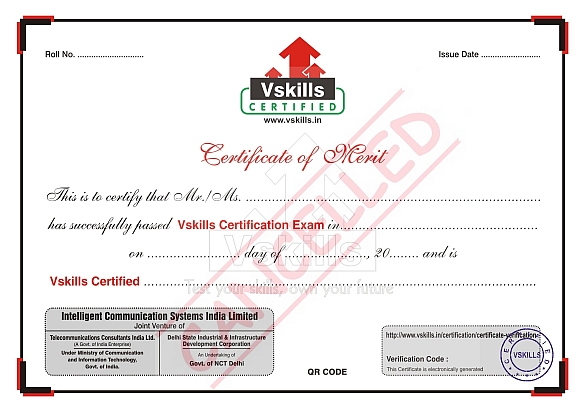- Duration / Course length: 1 To 2 Months Start now
- Certificates:
- Course delivery: This course is delivered in video format
Course details
Engineering Design is the process of devising a system, component, or process to meet desired needs. The course, Engineering Design, is specially made to teach the decision-making process (often iterative) in which the basic sciences, mathematics, and engineering sciences are applied to convert resources optimally to meet a stated objective. The course is very beneficial for engineering and management professionals or students pursuing post graduation studies.The certification tests the candidates on various areas in product planning, product specifications, prototyping, design for quality and reliability.
Why should one take this certification?
Earning Vskills Engineering Design Professional Certification can help candidate differentiate in today's competitive job market, broaden their employment opportunities by displaying their advanced skills, and result in higher earning ;
Who will benefit from taking this certification?
This Course is intended for engineering designers and product developers wanting to excel in their chosen areas. It is also well suited for those who are already working and would like to take certification for further career progression.
Table of Contents
Engineering Design Basics
- What is Design
- What is Engineering Design
- Types of Design
- Engineering Design Process
- Systems Thinking
- Design Process
- Product development Process
- Product Life Cycle
- New Product Development
- Organisation Structure
- Product and Functional Organisation
- Concurrent Engineering
- What is Product Planning
- Why Product Planning is needed
- Product Planning Elements
- Product Planning Phases
- Product Planning Strategy Guidelines
- Marketing Basics
- Marketing Research
- Market Segmentation
- Market Targeting
- Market Positioning
- Branding
- Factors influencing consumer behaviour
- Major Psychological Processes
- Buying Decision Process
- Organisational Buying
- Customer Data Collection and Analysis
- Voice of Customer (VOC)
- User Requirements
- What are Specifications?
- Characteristics of Specifications
- Detailing User Requirements
- Common Design Needs
- Requirements to Specifications
- Quality Function Deployment (QFD)
- User Requirements Priority and Kano Model
- Documenting User Requirements
- Concept Generation Basics
- Techniques to Promote Concept Generation
- Creative Thinking
- Problem Solving
- Brainstorming
- Nominal Group Technique (NGT)
- 6-3-5 Brainwriting
- Morphological Analysis
- TRIZ
- Axiomatic Design
- Concept Selection
- Pugh Concept Selection
- Weighted Decision Matrix
- Analytical Hierarchy Process
- Multi-Voting
- Decision Making
- Concept Testing
- Product Architecture Basics
- Integral Architectural Design
- Modular Architectural Design
- Configuration Design
- Parametric Design
- Modeling and Simulation
- Product Generation
- Industrial Design Basics
- Evolution of Industrial Design
- Industrial Design Process
- Industrial Design Protection
- DFM Basics
- DFM Guidelines
- DFA
- What is Quality
- DFQ Relevance
- Implementing DFQ
- Six Sigma Basics
- Lean Basics
- Design for Cost Basics
- Concepts of Cost
- Classification of Costs
- Cost Contributors
- Cost and Design
- Means of Reducing Cost
- Activity Based Costing
- Target Costing
- Value Engineering
- Reliability Basics
- Reliability Engineering Tools
- Design Evaluation
- DfR Basics
- DfR Components
- DfR Process
- Improving Reliability by Design
- DfR Guidelines
- D4S Basics
- Sustainability Issues
- Life Cycle Design
- Life Cycle Assessment
- Design for Environment
- Triple Bottom Line
- What is a prototype?
- Prototype Categories
- Prototype vs. a final product
- Why to Prototype
- Prototyping Components and Techniques
- Project Charter and Plan
- Stakeholder Management
- Project Plan
- Project Scope
- Project Metrics
- Project Documentation
- Project Closure





